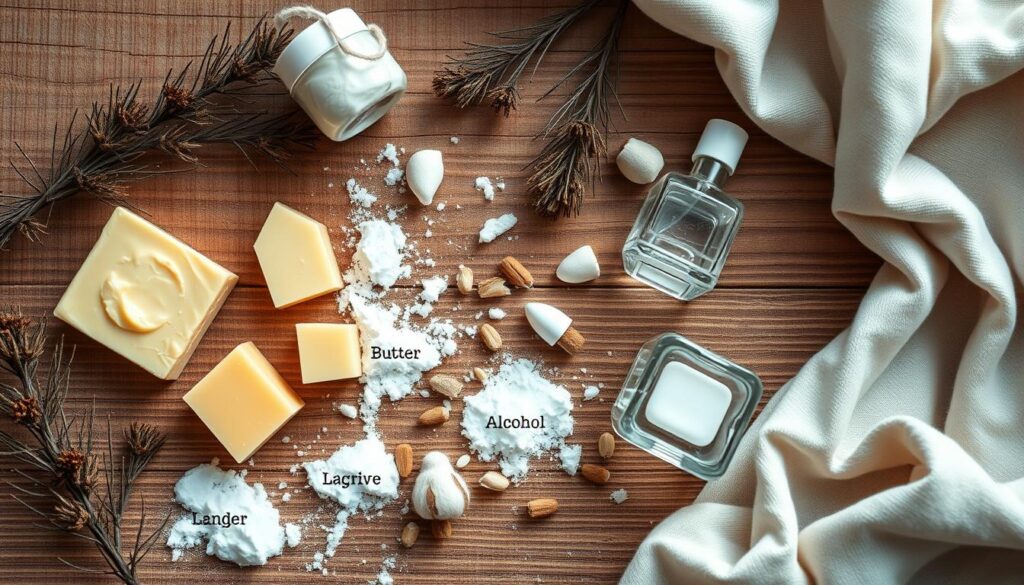Top 7 Mistakes People Make When Moisturizing in Winter
Did you know that over 75% of adults experience dry, irritated skin during the winter months? This alarming statistic highlights the critical importance of proper moisturizing techniques to combat the harsh effects of cold and dry weather on our skin. From failing to apply moisturizer at the right time to using the wrong formula, common missteps can leave your complexion dull, flaky, and vulnerable to additional damage.
Key Takeaways
- Understand how cold weather and indoor heating impact the skin’s natural moisture barrier
- Identify the best time and techniques for applying moisturizer during winter
- Learn to choose the right moisturizing formula for your skin type and needs
- Discover overlooked areas that require special attention and care
- Recognize the signs of over-moisturizing and how to avoid it
Understanding Winter’s Impact on Skin Health
As the winter season approaches, it’s crucial to understand how the colder weather can impact the health and moisture levels of our skin. The harsh, dry conditions during this time of year can compromise the skin’s natural barrier, leading to increased dryness, sensitivity, and irritation.
How Cold Weather Affects Skin Barrier
The cold, windy weather and low humidity levels common in winter can strip the skin of its natural oils and compromise its protective barrier. This disruption in the skin’s barrier function allows for increased water loss, leaving the skin feeling tight, itchy, and dehydrated.
The Science Behind Winter Skin Dryness
The lack of moisture in the air during winter is a primary contributor to dry skin. The low humidity levels mean that the skin cannot absorb and retain the necessary amount of water, resulting in a dull, flaky complexion. This dryness can also exacerbate conditions like eczema and psoriasis.
Indoor Heating Effects on Skin
While seeking refuge from the cold by turning up the heat indoors, we may inadvertently be harming our skin. The dry, warm air produced by heating systems further depletes the skin’s moisture, leading to a vicious cycle of dryness and discomfort.
Understanding these key factors that contribute to winter skin woes is crucial for developing an effective skincare routine to keep your skin healthy and hydrated throughout the colder months.
Using Water That’s Too Hot During Winter Showers
During the winter months, it’s tempting to indulge in long, hot showers to warm up and soothe the body. However, this can actually do more harm than good when it comes to maintaining healthy, moisturized skin. Experts recommend keeping the shower temperature somewhere between 98°F and 105°F, as hotter water can strip the skin of its natural oils, leading to increased dryness and irritation.
The pH of our skin is naturally around 5.4, while harsh soaps with a high pH (between 9 and 10) can disrupt the skin’s protective barrier. Instead, opt for gentle, pH-balanced cleansers with a pH range of 5.5 to 7, which will help maintain the skin’s natural acidic mantle and prevent excessive dryness.
To combat the effects of winter weather and indoor heating, it’s essential to keep shower duration limited to 10-15 minutes. Prolonged exposure to water, even at lukewarm temperatures, can lead to a reduction in the skin’s natural oils, contributing to various issues like dry skin, hair damage, and increased sensitivity.
Immediately after stepping out of the shower, be sure to moisturize your body to lock in hydration. Look for products containing humectants, such as hyaluronic acid and glycerin, which draw moisture into the skin, and emollients, such as petroleum-based ingredients, which create a protective barrier to prevent water loss.
By following these simple tips, you can enjoy the warmth of a winter shower without compromising the health and moisture levels of your skin.
Moisturizing tips to keep skin soft
As the chilly winter winds blow, it’s crucial to maintain a hydrating skincare routine to keep your skin soft and supple. The key is to apply moisturizer at the right time and using the proper techniques for maximum benefits. By following these simple tips, you can combat the drying effects of winter and enjoy a healthy, glowing complexion.
Best Time to Apply Moisturizer
The best time to apply moisturizer is immediately after cleansing, when your skin is still damp. This allows the moisturizer to lock in the moisture and better penetrate the skin. Consider using a hydrating serum before your moisturizer for an extra boost of hydration.
Proper Application Techniques
When applying moisturizer, use gentle, upward motions to massage it into your skin. Avoid harsh rubbing, as this can irritate the delicate skin barrier. Pay special attention to areas prone to dryness, such as elbows, knees, and the sides of the nose.
Product Layering Guidelines
Follow the rule of layering your skincare products from thinnest to thickest consistency. Start with a lightweight serum, then apply your moisturizer, and finish with a facial oil or balm if needed. This allows each product to work effectively without interfering with the absorption of the others.
By incorporating these moisturizing tips into your winter skincare routine, you can maintain a hydrating skincare routine and keep your skin moisturizing for dry skin all season long. Enjoy the facial moisturizing benefits of a soft, supple complexion throughout the colder months.

Choosing the Wrong Moisturizer Formula for Winter
As the colder months approach, it’s essential to switch up your skincare routine to accommodate the unique needs of winter skin. During this time, your skin is more prone to dryness, flakiness, and irritation due to the harsh environmental factors.
To combat these winter woes, it’s crucial to choose a moisturizer that provides intense hydration and nourishment. Look for moisturizer formulas that are rich in best moisturizer ingredients like hyaluronic acid, glycerin, and ceramides. These ingredients work together to lock in moisture, strengthen the skin’s barrier, and prevent further water loss.
Steer clear of alcohol-based moisturizers, as they can further strip your skin of its natural oils, leading to increased dryness and discomfort. Instead, opt for creams or ointments that have a thicker, more emollient texture. These formulas are better equipped to moisturizing for dry skin and provide the deep nourishment your skin craves during the winter season.
Remember, the key to maintaining healthy, glowing skin throughout the winter is finding the right moisturizer that addresses your skin’s unique needs. By incorporating the right ingredients and textures, you can keep your complexion hydrated, supple, and protected from the harsh elements.
Neglecting Essential Body Parts When Moisturizing
When it comes to maintaining soft, supple skin during the winter months, many people often overlook key areas that require extra attention. From the delicate neck and décolletage to the hardworking hands and feet, neglecting these essential body parts can lead to dryness, flakiness, and an overall lackluster appearance.
Often Forgotten Areas
The neck and décolletage are particularly vulnerable to the harsh effects of winter. Frequently exposed to the elements and often forgotten in daily moisturizing routines, these areas can quickly become dry and show premature signs of aging. Incorporating a nourishing neck cream or serum into your skincare regimen can help to improve the appearance of fine lines and wrinkles, while also keeping the skin hydrated and radiant.
Special Care for Hands and Feet
Our hands and feet bear the brunt of winter’s toll, with constant exposure to the cold and frequent hand-washing. To maintain soft, supple skin, be sure to apply a rich, emollient-based hand cream after every wash and consider wearing cotton gloves overnight to lock in moisture. For the feet, a deeply hydrating foot cream or balm can work wonders, especially when paired with a pair of cozy socks to seal in the benefits.
Lip Care Importance
No winter skincare routine is complete without attention to the delicate lips. Prone to dryness, cracking, and irritation, the lips require regular application of a nourishing lip balm to prevent chapping and maintain a smooth, healthy appearance. Look for formulas containing ingredients like shea butter, beeswax, or glycerin to provide long-lasting hydration and protection.
By giving extra care and attention to these often-neglected areas, you can ensure that your entire body remains soft, supple, and radiant throughout the winter season. Incorporating body moisturizing after shower and following other moisturizing tips can help keep your skin looking and feeling its best.
Incorrect Timing of Moisturizer Application
Timing is a crucial aspect of your hydrating skincare routine. Applying moisturizer at the right time can make all the difference in locking in precious skin-nourishing hydration, especially during the harsh winter months.
One of the biggest mistakes people make is not applying moisturizer within 3 minutes of cleansing or showering. This crucial window of time is when your skin is most receptive to absorbing hydrating ingredients. By acting quickly, you can seal in moisture and prevent it from evaporating, leaving your skin moisturizing techniques more effective.
Consider incorporating a dedicated nighttime moisturizer into your routine for intense overnight hydration. These richer, creamy formulas work hard to replenish and restore your skin while you sleep. Reapply your moisturizer throughout the day, especially after activities like hand washing or exposure to harsh winter weather conditions that can strip away natural moisture.
| Product | Rating | Price |
|---|---|---|
| Peter Thomas Roth Water Drench Moisturizer | 4.9/5 stars | $34.66 (33% off) |
| Missha Time Revolution The First Essence 5X | 4.6/5 stars | N/A |
| Cosrx Advanced Snail 96 Mucin Power Essence | 4.6/5 stars | N/A |
By following these hydrating skincare routine tips, you can ensure your skin moisturizing techniques are as effective as possible, keeping your complexion healthy and radiant all winter long.
Overlooking Natural Skin Moisturizing Methods
While topical moisturizers play a crucial role in maintaining skin’s hydration during the winter months, there are natural ways to complement your skincare routine and keep your complexion soft and supple. Paying attention to your diet, hydration levels, and home environment can provide an additional boost to your natural skin moisturizers and moisturizing tips to keep skin soft.
Diet and Hydration Impact
Consuming foods rich in omega-3 fatty acids and antioxidants, such as salmon, avocados, and nuts, can help support your skin’s health from within. Additionally, staying hydrated by drinking plenty of water throughout the day is essential for maintaining your skin’s natural moisture levels.
Humidity Control at Home
- Use a humidifier in your bedroom and living areas to add moisture to the dry, winter air.
- Consider incorporating natural oils, like coconut oil or jojoba oil, into your skincare routine for an extra layer of hydration.
- Limit the use of hot water when showering, as it can strip your skin of its natural oils.
By addressing both internal and external factors, you can enhance your skin’s natural moisturizing capabilities and keep it soft, supple, and healthy throughout the winter season.
Ignoring Signs of Over-Moisturizing
When it comes to winter skin care, it’s essential to strike the right balance between moisturizing and over-moisturizing. While keeping your skin hydrated is crucial during the dry, cold months, ignoring the signs of over-moisturizing can lead to a range of problems, from clogged pores to increased oiliness.
One of the key indicators of over-moisturizing is the appearance of breakouts or congestion in the skin. If you notice an increase in blemishes or a general feeling of heaviness or greasiness, it might be time to reassess your moisturizing routine. Additionally, pay attention to the texture and appearance of your skin – if it looks and feels overly shiny or slick, it could be a sign that you’re using too much product.
To combat the issue of over-moisturizing, try incorporating lighter, oil-free formulas into your routine, especially in areas that are more prone to acne or excess oil production, such as the T-zone. Reserve heavier, richer creams for the drier areas of your face and body, where they can provide the necessary hydration without overwhelming the skin.
| Signs of Over-Moisturizing | Solutions |
|---|---|
|
|
By staying vigilant and adjusting your moisturizing routine as needed, you can ensure that your skin remains healthy, hydrated, and balanced throughout the winter months, without the risk of over-moisturizing. Remember, the key to great winter skin is finding the right balance and responding to your skin’s unique needs.
Common Ingredients to Avoid in Winter Moisturizers
As the colder months approach, it’s essential to be mindful of the ingredients in your moisturizers to ensure your skin stays healthy and hydrated throughout the winter. Avoid products containing alcohol, fragrances, or harsh exfoliants that can further irritate and dry out your skin during this time of year.
Additionally, be cautious with retinoids and alpha-hydroxy acids, as they can increase skin sensitivity, leading to redness and discomfort. Instead, opt for gentle, non-comedogenic formulas that won’t clog your pores.
Look for moisturizers that contain antioxidants and peptides to provide added anti-aging benefits during the winter months. These ingredients can help to nourish and protect your skin, leaving it soft, supple, and radiant even in the harshest of winter climates.
| Ingredient | Impact on Winter Skin |
|---|---|
| Alcohol | Can further dry out and irritate the skin |
| Fragrances | May cause skin sensitivity and irritation |
| Harsh Exfoliants | Can strip the skin’s natural oils, leading to dryness |
| Retinoids | Increase skin sensitivity, leading to redness and discomfort |
| Alpha-Hydroxy Acids | Can also increase skin sensitivity in winter |
By avoiding these problematic ingredients and opting for gentle, moisturizing formulas with beneficial antioxidants and peptides, you can help keep your skin best moisturizer ingredients and anti-aging moisturizing throughout the winter season.

Conclusion
Maintaining healthy, hydrated skin during the winter season requires a diligent approach to moisturizing. By avoiding common mistakes and incorporating the right moisturizing tips to keep skin soft, individuals can combat the drying effects of cold weather and indoor heating. From choosing appropriate products to applying them correctly and addressing all areas of the body, these winter skin moisturizing techniques are crucial for preserving skin’s natural barrier and promoting overall skin health.
Combining topical treatments with lifestyle adjustments, such as managing indoor humidity and maintaining a balanced diet, can further enhance the skin’s ability to retain moisture and withstand the harsh winter conditions. By staying vigilant and adopting a comprehensive skincare routine, individuals can ensure their skin remains soft, supple, and radiant throughout the colder months.
Ultimately, proper moisturizing tips to keep skin soft and winter skin moisturizing strategies are essential for maintaining healthy, hydrated skin during the winter season. By addressing the unique challenges posed by cold weather and implementing the right practices, individuals can effectively protect and nourish their skin, ensuring a glowing complexion all year round.







